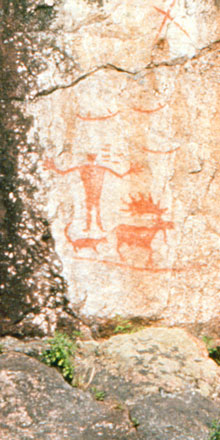Story behind the PIT Moose - Passport in Time
Main menu:
About > PIT's Beginnings
Story behind the PIT Moose
by Gordon Peters, former archaeologist for Superior National Forest and founder of PIT
 When Passport in Time first began on national forests in Minnesota and Wisconsin in 1988, the logo was a complicated collage of objects of antiquity, which included a pictograph of a moose. In those days, PIT was not yet a national program, and I wore many hats—project leader, program administrator, and volunteer coordinator. PIT was my baby, and I had a history with this pictograph, so when the need arose for a simpler logo, the moose was it! It was not without a struggle. When PIT became national, many regions didn’t identify with the moose. Here is why I fought to keep him.
When Passport in Time first began on national forests in Minnesota and Wisconsin in 1988, the logo was a complicated collage of objects of antiquity, which included a pictograph of a moose. In those days, PIT was not yet a national program, and I wore many hats—project leader, program administrator, and volunteer coordinator. PIT was my baby, and I had a history with this pictograph, so when the need arose for a simpler logo, the moose was it! It was not without a struggle. When PIT became national, many regions didn’t identify with the moose. Here is why I fought to keep him.I believe a pictograph is the perfect logo for the PIT program. Rock art conveys a sense of antiquity that spans both prehistory and history; it is mysterious—it does not reveal everything—and it is an experience in itself. Anyone who has seen a pictograph or petroglyph knows what I mean. To see a pictograph for the first time is to feel a connection with the past that no other experience in archaeology or history can evoke. I wanted volunteers to feel that way about their PIT experience.
My relationship with the PIT moose began when I received a call from a wilderness ranger who told me someone had been using the Hegman Lake pictographs for target practice. He invited me to accompany him to the site the next day. We met in Ely early the following morning and drove to the Boundary Waters Canoe Area Wilderness entry point. In my excitement, I volunteered to portage the canoe from the parking lot to the lake. I was young and naive. For those who haven’t portaged a canoe, the canoe is flipped upside down and placed on your shoulders. This means your head is inside the canoe and you can see only your feet and the area directly in front of them. The upside-down canoe also serves as an excellent trap for mosquitoes and biting flies.
As I stumbled down the portage, my eyes fixed on a pair of hooves immediately in front of me, and I put on the brakes. I lifted the bow of the canoe and came eye to eye with a bull moose. I never knew they grew that big! After staring me down for a few minutes, he walked off the trail and into the forest. He never looked back. He was my first moose sighting in the wild.
After a short paddle and portage into South Hegman Lake, then a little more paddling, we arrived at the pictographs. They were wonderful! Bright red on a light gray rock face, the moose immediately caught my eye. He was awesome! And then we saw it: a small chip of paint was missing from where the moose’s heart would have been. There were other fresh bullet scars on the rock face from vandals, trying to kill an ancient painted moose. We never caught them.
That was my introduction to moose, to pictographs, and to wanton destruction of beauty and history. When I conceived of PIT, it was to provide an opportunity for the public to get involved in heritage activities and to foster a preservation ethic in the participants. Perhaps PIT volunteers will help prevent the vandalism that occurred to Mr. Moose and to thousands of other heritage sites. This is why I voted that he remain our logo. He is special to me, and now, I hope, to you as well.
As a final note, I should mention that we don’t know how old the pictographs at Hegman Lake are, and that’s all right with me. To me, the moose represents objects of antiquity from all time periods, all of which are worthy of protection. Don’t you agree?